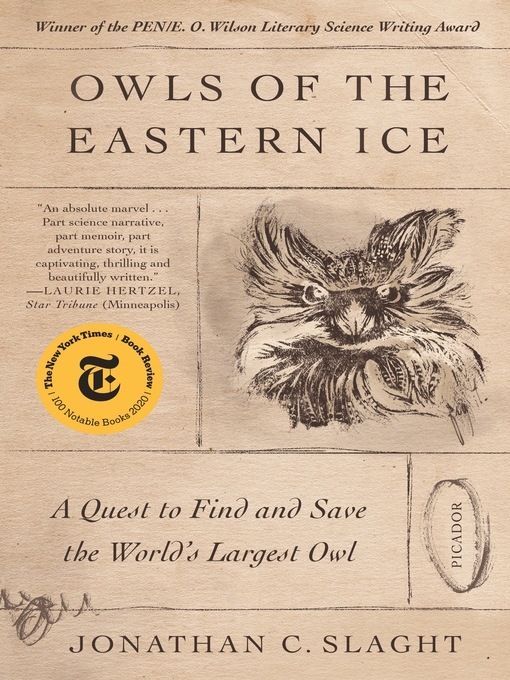
Owls of the Eastern Ice
A Quest to Find and Save the World's Largest Owl
کتاب های مرتبط
- اطلاعات
- نقد و بررسی
- دیدگاه کاربران
نقد و بررسی

Starred review from March 1, 2020
An American scientist chronicles his travels through remote Russian landscapes to study the elusive and endangered Blakiston's fish owl. From the very first pages, Slaght, the Russia and Northeast Asian Coordinator for the Wildlife Conservation Society, grips readers with vivid language and tight storytelling. His many months trekking through the icy wilderness to find and track rare fish owls--the largest owl on Earth--inform a narrative that blends field research, personal journey, and adventure writing. Part of the book's success lies in the author's ability to present the stakes and draw out the tension therein, making what could be a dry tale of bird-watching a compelling story of the necessity of conservation. In this case, the stakes include the owls' disappearing habitat but also Slaght's livelihood. "Fieldwork is often regular repetition of challenging or unpleasant activities," writes the author, "an application of persistent pressure to a question until the answer finally emerges." In the bitter cold terrain of eastern Russia, it's that much more difficult. Throughout the book, Slaght lives up to his rugged-conservationist persona as he writes of helter-skelter snowmobile trips circumnavigating rushing rivers of ice, vodka-soaked encounters with village locals, and solitary, achingly beautiful nights observing the majestic owls firsthand. He is an engaging writer who imbues each scene with an intimate sense of place. "The nights dragged on," he writes, "a deep winter stillness perforated by occasional firecracker-like pops: ice expanding in tree cracks as air temperatures plummeted after sunset. The adult female fish owl was like a ghost. We heard her vocalize with her mate almost every night, but she appeared onscreen only once, when she hit our snare but pulled the knot free before we reached her." The cast of characters he brings to life--both human and avian--illuminates the delicate symbiosis of the natural world and sheds a welcome light on the remarkable creatures that are too little known. Top-notch nature writing in service of a magnificent, vulnerable creature.
COPYRIGHT(2020) Kirkus Reviews, ALL RIGHTS RESERVED.

Starred review from April 1, 2020
Slaght recounts his five-year study of Blakiston's fish owls: raptors notable for their large size, rarity, and habitat (shared with Amur tigers) in southeastern Russia. The author, now the Russia and Northeast Asia Coordinator for the Wildlife Conservation Society, is a young PhD candidate looking for a research topic when the book begins. He's essentially starting from scratch, since so little was known about the birds. As fine a writer as he is scientist, Slaght gives the narrative an enticing structure; it's well into the book before he gets a good look at the cryptic species. Information about fish owl behavior and biology is gradually revealed as his knowledge expands. Readers learn much about the vagaries of scientific fieldwork, including the worries caused by severe weather, equipment failure, and project funding issues. While the birds are marvelous, there's a compelling human side to the story as well as Slaght describes his interactions with local scientists and research assistants. VERDICTS Slaght's extensive field research is rendered into clear, readable prose, making it a solid choice for bird lovers, but also for armchair travelers looking for eco-adventure on the fringes of civilization.--Robert Eagan, Windsor P.L., Ont.
Copyright 2020 Library Journal, LLC Used with permission.

April 15, 2020
Primorye is the southeasternmost district of Russia, bordering on North Korea and China, and home to Amur tigers, primeval forests, salmon streams, and the world's largest owl, Blakiston's fish owl, an eagle owls and a distant cousin of North America's great horned owl. When biologist Slaght saw one for the first time he was captivated, and parlayed his years of experience in Russia into a PhD project studying the fish owl, with the aim of conserving it and its habitat. The owls are secretive and hard to find, which, coupled with the wintry wilderness setting, makes for an adventurous tale. Slaght learns how to look for owls as well as how to get along with the hard-drinking locals and survive the cold. The excitement of finding owl tracks in the snow (the owls fish for salmon along open stretches of rivers) and owl nests is intertwined with stories of camping, attaching transmitters to owls, and dealing with recalcitrant equipment and villagers. Slowly the owls reveal their secrets, and Slaght lets readers revel in the discoveries along with him.(Reprinted with permission of Booklist, copyright 2020, American Library Association.)

























دیدگاه کاربران